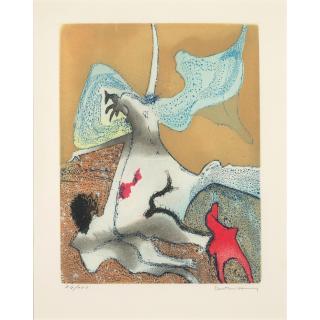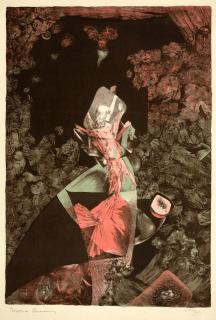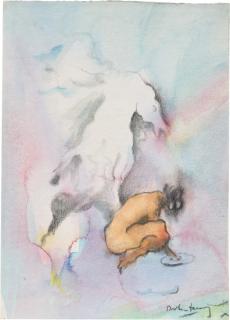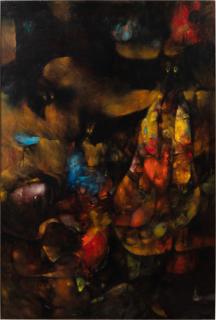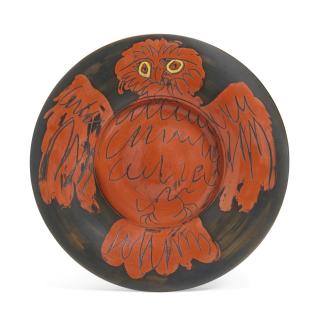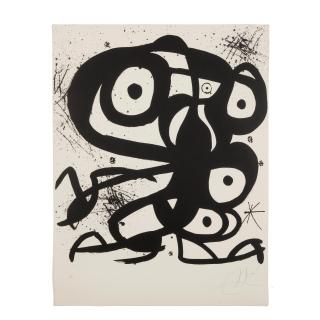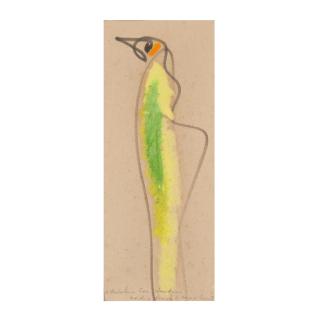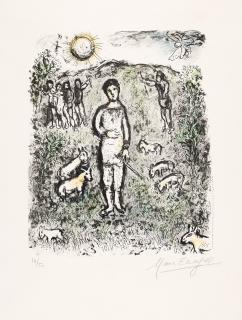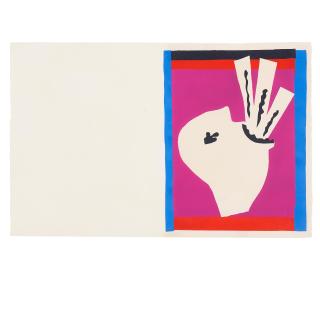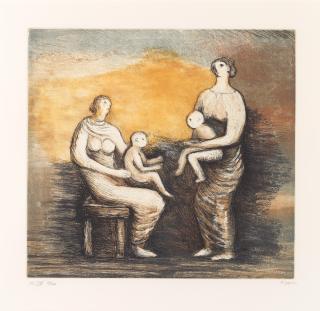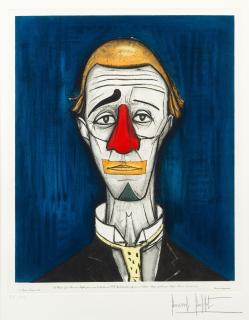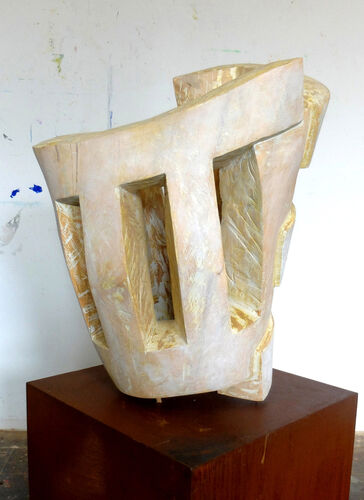Dorothea Tanning 1910 - 2012
The artist Dorothea Tanning
- American Surrealist artist as well as writer, sculptor and stage designer.
- Starting in the 1950s, she broke away from the surreal and developed her own style.
- Published her second volume of poetry at the age of 101.
Dorothea Tanning herself was an important artist, even if she is much more known in retrospect as the wife of Max Ernst. Just like her husband, Tanning gave herself over to surrealist painting. But Tanning, who was born in 1910 in the US state of Illinois, was capable of much more than that: in addition to her painting, she was also active as a sculptor, writer, stage designer and costume designer. The self-taught artist gathered her experience and inspiration primarily in exhibitions - the 1936 exhibition Fantastic Art, Dada and Surrealism at the Museum of Modern Art in New York, where she had moved a year earlier, is considered to have had a particularly formative influence on her.
For Tanning, the Surrealism and Dadaism had been completely unknown up to that point. The event eventually led her to turn to popular Surrealism as well. Seven years later, Tanning was pleased to participate in a collective exhibition that exclusively featured the works of women: Exhibition by 31 Women (1943) at Peggy Guggenheim's Art of This Century gallery featured her Birthday (1942), a self-portrait, alongside artists such as Frida Kahlo, Louise Nevelson, and Meret Oppenheim.
This exhibition can probably be seen as another key experience on several levels - her later husband Max Ernst was still in his third marriage to gallery owner Peggy Guggenheim at the time. Three years later, the two married in a double wedding to Surrealist Man Ray and his wife Juliet Man Ray (née Browner). Like Ernst, Tanning entered the important Bel Ami art competition in 1946. This was followed by multiple changes of residence to and within France in the 1950s. Tanning's work became increasingly abstract, and she made revolutionary sculptures out of fabric, with which she addressed the fragility of life.
In 1959, Tanning was represented at documenta II, and in 1974 the Centre Pompidou in Paris was already dedicating a retrospective to her work, without knowing how old the then 64-year-old would become. Two years later, when the two were living in the French capital, her husband Ernst died at the age of 85. The widowed artist returned to New York in 1978. Once there, she eventually turned to writing. Tanning died in early 2012 at the proud age of 101 - only a short time before, her second volume of poetry, Coming to That, had been published.
Die Künstlerin Dorothea Tanning
- Künstlerin des Surrealismus sowie Schriftstellerin, Bildhauerin und Bühnenbildnerin.
- Ab den 1950ern löste sie sich vom Surrealen und entwickelte einen eigenen Stil.
- Veröffentlichte im Alter von 101 Jahren ihren zweiten Gedichtband.
Dorothea Tanning selbst war eine wichtige Künstlerin, auch wenn sie im Nachgang viel mehr als Ehefrau von Max Ernst bekannt ist. Genau wie ihr Ehemann gab sich auch Tanning der surrealistischen Malerei hin. Doch die 1910 im US-amerikanischen Bundesstaat Illinois geborene Tanning konnte noch weit mehr als das: Sie war neben ihrer Malerei außerdem als Bildhauerin, Schriftstellerin, Bühnenausstatterin und Kostümbildnerin tätig. Die Autodidaktin sammelte ihre Erfahrungen und Inspirationen vornehmlich in Ausstellungen – als besonders prägend für sie gilt die 1936 abgehaltene Ausstellung Fantastic Art, Dada and Surrealism im Museum of Modern Art in New York, wo sie ein Jahr zuvor hingezogen war.
Für Tanning waren der dort zur Schau gestellte Surrealismus und Dadaismus bis zu diesem Zeitpunkt noch völlig unbekannt. Die Veranstaltung brachte sie schließlich dazu, sich ebenfalls dem angesagten Surrealismus zuzuwenden. Sieben Jahre später konnte sich Tanning über die Teilnahme an einer Gemeinschaftsausstellung freuen, auf der ausschließlich die Werke von Frauen gezeigt wurden: In Exhibition by 31 Women (1943) in der Galerie Art of This Century von Peggy Guggenheim war sie mit Birthday (1942), einem Selbstporträt, neben Künstlerinnen wie Frida Kahlo, Louise Nevelson oder Meret Oppenheim vertreten.
Für Tanning kann diese Ausstellung wohl auf mehrfacher Ebene als weiteres Schlüsselerlebnis betrachtet werden – ihr späterer Ehemann Max Ernst befand sich zu diesem Zeitpunkt noch in dritter Ehe mit Galeristin Peggy Guggenheim. Drei Jahre später heirateten die beiden im Rahmen einer Doppelhochzeit mit Surrealist Man Ray und seiner Frau Juliet Man Ray (geb. Browner). Genau wie Ernst nahm auch Tanning 1946 am bedeutenden Bel-Ami-Kunstwettbewerb teil. In den 1950er Jahren folgte ein mehrfacher Wohnsitzwechsel nach und innerhalb Frankreichs. Tanning arbeitete zunehmend abstrakter und sie fertigte revolutionäre Skulpturen aus Stoff, mit denen sie die Fragilität des Lebens thematisierte.
1959 war Tanning auf der documenta II vertreten, 1974 widmete das Centre Pompidou in Paris ihrer Arbeit bereits eine Retrospektive, ohne zu wissen, wie alt die damals 64-Jährige werden würde. Zwei Jahre später, die beiden lebten gerade in der französischen Hauptstadt, starb Ehemann Ernst im Alter von 85 Jahren. Die verwitwete Künstlerin kehrte 1978 nach New York zurück. Dort angekommen wandte sie sich schließlich der Schriftstellerei zu. Tanning starb Anfang 2012 in einem stolzen Alter von 101 Jahren – nur kurz zuvor war ihr zweiter Gedichtband Coming to That erschienen.
Dorothea Tanning in a nutshell
The surrealist oil painting Birthday Painting by Dorothea Tannings dates from 1942, a time when the artist lived in New York for the first time. It shows a young mannequin looking directly at the viewer - her chest is bare, while her arms are wrapped in a velvety bolero jacket. A train of green roots rises from the jacket's royal-looking purple fabric. A black cloth covers the front part of the legs. The resigned look of the young woman is explained by the setting in which she finds herself: A room that resembles a hall of mirrors with the illusion of infinite doors. A mystical, winged creature settled on the floor in front of her feet: The gargoyle-like creature stands out with its fixed, fearful gaze. The painting measures 40 1/4 × 25 1/2 inches (102.2 × 64.8 cm) and is in the Philadelphia Museum of Art, where it is also on display.
The oil painting Eine Kleine Nachtmusik (A Little Night Music) by Dorothea Tanning from 1943 belongs to the collection of the Tate Gallery in London, which loans it frequently for special exhibitions to other museums such as the Musée d'Art moderne et contemporain de Strasbourg. It depicts a scene in a dreary hotel hallway with elements that seem to be haunted by unnatural forces. The giant sunflower and the little girls, some of whose hair stands on end, exude something nightmarish. She borrowed the title from one of Mozart’s chamber works.
The vertical oil painting Insomnias (1957) by Dorothea Tanning is currently (2023) owned by the Moderna Museet in Stockholm.
Häufige Fragen zu Dorothea Tanning
Das surrealistische Ölgemälde Geburtstag (engl. Birthday Painting) von Dorothea Tannings stammt aus dem Jahr 1942, einer Zeit, in der die Künstlerin in das erste Mal in New York lebte. Es zeigt ein junges Mannequin, das die Betrachtenden direkt anblickt – ihre Brust ist entkleidet, während ihre Arme in ein samtig-glänzende Bolerojacke gehüllt sind. Aus dem royal anmutenden, purpurnen Stoff der Jacke ragt eine Schleppe aus grünen Wurzeln. Ein schwarzes Tuch bedeckt den vorderen Teil der Beine. Der resignierte Blick der jungen Frau erklärt sich durch die Kulisse, in der sie sich befindet: Ein Raum, der einem Spiegelkabinett mit der Illusion von unendlichen Türen gleicht. Vor ihr auf dem Boden hat sich eine mystische, beflügelte Kreatur niedergelassen: Das gargoyle-artige Wesen sticht mit seinem starr-ängstlichen Blick hervor. Das Gemälde misst 40 1/4 × 25 1/2 inches (102.2 × 64.8 cm) und befindet sich im Philadelphia Museum of Art, wo es auch ausgestellt ist.
Das Ölgemälde Eine Kleine Nachtmusik von Dorothea Tanning aus dem Jahr 1943 gehört zur Sammlung der Tate Gallery in London, die es immer wieder für Sonderausstellungen als Leihgabe an andere Museen wie etwa das Musée d’Art moderne et contemporain de Strasbourg weitergibt. Es zeigt eine Szene in einem tristen Hotelflur mit Elementen, die von unnatürlichen Kräften heimgesucht zu sein scheinen. Die riesige Sonnenblume und die kleinen Mädchen mit ihren teils zu Berge stehenden Haaren strahlen etwas Albtraumhaftes aus. Den Titel hat sie einem Mozart-Kammerstück entlehnt.
Das vertikale Ölgemälde Insomnias (1957) von Dorothea Tanning befindet sich derzeit (2023) im Besitz des Moderna Museet in Stockholm.
Dorothea Tanning quotes
Zitate von Dorothea Tanning
Dorothea Tanning in News and Exhibitions
Networks of Surrealism
How did personal relationships contribute to the spread of Surrealism? In the exhibition Max Ernst to Dorothea Tanning. Networks of Surrealism. Provenances from the Ulla and Heiner Pietzsch Collection, the Neue Nationalgalerie explores this question with numerous prominent examples. The show opens on October 17 in Berlin.
Farleys House & Gallery presents prints by Dorothea Tanning
The Farleys House & Gallery museum near Chiddingly will present the exhibition Dorothea Tanning: Printmaker from April to May 2022. As the name suggests, the focus of the solo show is primarily on the many prints Tanning made, among others, during her 20 years in France.
Dorothea Tanning in News and Exhibitions
Netzwerke des Surrealismus
Wie haben persönliche Beziehungen zur Verbreitung des Surrealismus beigetragen? In der Ausstellung Max Ernst bis Dorothea Tanning. Netzwerke des Surrealismus. Provenienzen der Sammlung Ulla und Heiner Pietzsch geht die Neue Nationalgalerie der Frage anhand zahlreicher prominenter Beispiele nach. Die Schau eröffnet am 17. Oktober in Berlin.
Farleys House & Gallery präsentiert Grafiken von Dorothea Tanning
Das Museum Farleys House & Gallery bei Chiddingly zeigt von April bis Mai 2022 die Ausstellung Dorothea Tanning: Printmaker. Wie der Name vermuten lässt, liegt der Fokus der Einzelschau vor allem auf den vielen Drucken, die Tanning u. a. während ihrer 20 Jahre in Frankreich angefertigt hat.




